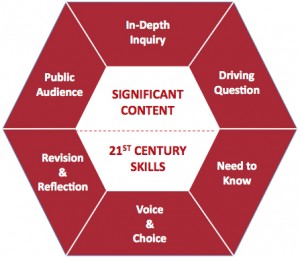So you want to get started with Project-Based Learning?
We think that’s an awesome idea, and we want to provide a path to success. One of the first things we have to do when discussing PBL is explain why it’s important in today’s world. After all, PBL has been around since the early twentieth century when John Dewey advocated that students needed to learn by having experiences in the real world and not by memorizing packaged content. Go here to learn more about Dewey’s philosophy. The truth is that Dewey’s approach wasn’t really new either. The idea that people learn by doing and that learning should have practical value is obviously at the heart of the apprenticeship system, but in the last couple of centuries, emphasis on academic knowledge sidelined educational opportunities that focused on student-centered, immersive learning experiences. For more on this theme, check out Ken Robinson’s amazing RSA Animate video (Sir Ken’s TED Talk is also pretty paradigm shifting.)
What accounts for the adaptation of Dewey’s pedagogy, almost a century after he lived? Technology, we think, plays a large role. Today, students — anyone — can access information in a way that is unprecedented in human history, and they can also create using digital media in a way that is unique to the world. In fact, it’s often students who know more about technology than their teachers do, so for the first time a younger generation is more knowledgeable about something than their elders. We think that calls for a radical re-shifting of how learning takes place. And we’re not alone. Check out David Thornburg’s take on what school should look like:
Tony Wagner of the Harvard Graduate School of Education is also an education change agent. Here’s what he says in his book Creating Innovators:
“Most of our high schools and colleges are not preparing students to become innovators. To succeed in the 21st-century economy, students must learn to analyze and solve problems, collaborate, persevere, take calculated risks and learn from failure. . . . A handful of high schools, colleges and graduate schools are teaching young people these skills—places like High Tech High in San Diego, the New Tech high schools (a network of 86 schools in 16 states), Olin College in Massachusetts, the Institute of Design (d.school) at Stanford and the MIT Media Lab. The culture of learning in these programs is radically at odds with the culture of schooling in most classrooms.”
So we see that there is a serious need for PBL and the kind of thinking and learning it fosters. We’re ready then to get into some PBL basics. The Buck Institute of Education, dedicated to all things PBL, has a good definition of it, as well as a clear breakdown of its components:
Project Based Learning is a teaching method in which students gain knowledge and skills by working for an extended period of time to investigate and respond to a complex question, problem, or challenge. Essential Elements of PBL include:
- Significant Content - At its core, the project is focused on teaching students important knowledge and skills, derived from standards and key concepts at the heart of academic subjects.
- 21st century competencies - Students build competencies valuable for today’s world, such as problem solving, critical thinking, collaboration, communication, and creativity/innovation, which are explicitly taught and assessed.
- In-Depth Inquiry - Students are engaged in an extended, rigorous process of asking questions, using resources, and developing answers.
- Driving Question - Project work is focused by an open-ended question that students understand and find intriguing, which captures their task or frames their exploration.
- Need to Know - Students see the need to gain knowledge, understand concepts, and apply skills in order to answer the Driving Question and create project products, beginning with an Entry Event that generates interest and curiosity.
- Voice and Choice - Students are allowed to make some choices about the products to be created, how they work, and how they use their time, guided by the teacher and depending on age level and PBL experience.
- Critique and Revision - The project includes processes for students to give and receive feedback on the quality of their work, leading them to make revisions or conduct further inquiry.
- Public Audience - Students present their work to other people, beyond their classmates and teacher.
We also like this brief overview of PBL, again provided by BIE:
You can find all you need for PBL not only on BIE’s site but also through edutopia, which identifies PBL as one of its core strategies.
Another question that often comes up during a discussion of PBL is: what’s the difference between projects and project-based learning? We think this chart provides a good answer:
Take the time to truly examine the chart. You’ll find that PBL has some key features that we think are essential for deep and true learning:
student-centered learning
context for learning
built-in assessment (the project is the learning and doesn’t come after the learning)
emphasis on acquisition of skills as well as content
a public audience (think of how much more meaningful work can be for students when they know it will be seen by the world)
One final resource:
This past July, at the Summer Sandbox, our professional development workshop, educators got to experience PBL and create their own project-based learning units. This short video of the Sandbox can add to your understanding of the pedagogy:
Now that you’ve gotten an introduction of project-based learning, you can start thinking about how you’re going to marry your course content to the pedagogy.












